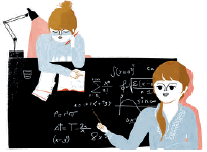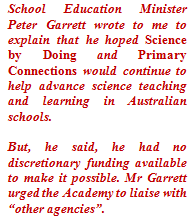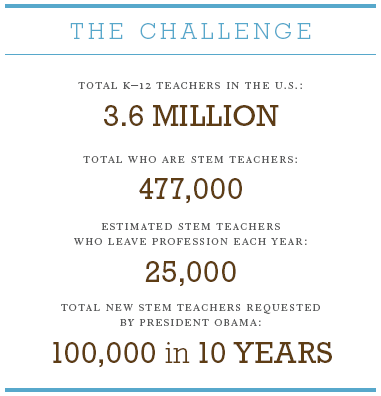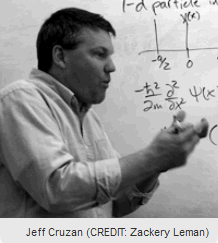|
News & Views item - November 2011 |
![]() I Have a Hazy Notion of What a Logarithm is. (November 20, 2011)
I Have a Hazy Notion of What a Logarithm is. (November 20, 2011)
That one-liner was the response of a first-year science student early in his first term at university in answer to a request in a maths tutorial.
Jan Thomas in her May 5, 2011 opinion piece for TFW issued a plea for mathematics and statistics in which she wrote:
 In
[Australian] secondary schools mathematics is the most widely reported area of
shortfall quoted by principals.
In
[Australian] secondary schools mathematics is the most widely reported area of
shortfall quoted by principals.
The percentage of graduating secondary teachers qualified to teach mathematics
is around 7%. The time in the school curriculum for mathematics is around 14%.
This supply and demand mismatch has existed for over ten years. It is not
surprising that the performance of Australia’s Year 8 students in TIMSS has gone
from statistically above both the UK and USA in the mid-90s to statistically
below both these countries.
The mathematics teacher problem is massive. New Year-7 mathematics teachers are
likely to be young female biology graduates who gave up mathematics well before
university. With no mathematics in their degrees they have not completed any
courses in teaching mathematics.
The downward spiral emerges of too few mathematical sciences graduates leading
to an inadequate supply of teachers, to school students not having a mathematics
education that leads to participation in the more advanced Year 12 subjects etc
Currently thousands of young Australians are deprived of an adequate education
in the mathematical sciences by virtue of an inadequate supply of properly
qualified mathematics teachers in schools that is compounded by woefully
under-resourced mathematics and statistics teaching in the universities.
While the details of short falls in teaching the sciences are different the overall effect is similar. And yet while our federal and state political leaders continue their self congratulations on altering curricula no serious attempt is being undertaken to alleviate the monumental short fall of qualified and inspirational primary and secondary school teachers for science and maths. We even have the drama of the President of the Australia Academy of Science pleading at her National Press Club address this past September:
We must place a much higher societal value on teachers and do everything we can
to recruit some of our brightest and best into teaching. We must support these
educators with the best tools and resources available and provide them with
stimulating opportunities for ongoing training.
support these
educators with the best tools and resources available and provide them with
stimulating opportunities for ongoing training.
I want [now] to focus on the Academy's two most recent science education programs: Primary Connections, for primary school; and Science by Doing, for junior secondary school. Both have received substantial funding and support from the Federal Government. ...Both of these programs are designed to invigorate science teaching. They enhance teachers' skills and emphasise engaging, inquiry-based approaches to guide and enthuse children's learning.
School Education Minister Peter Garrett wrote to me to explain that he hoped Science by Doing and Primary Connections would continue to help advance science teaching and learning in Australian schools.
But, he said, he had no discretionary funding available to make it possible. Mr Garrett urged the Academy to liaise with “other agencies”.
We believe all Australian students deserve access to such proven, quality programs. And so, even though it will take us longer and may not be able to be delivered equitably across Australian schools, the Academy is committed to rolling out Primary Connections and Science by Doing at cost price.
The November 2011 HHMI Bulletin features and article by Dan Ferber "Calling all Teachers" with the subhead "Everyone agrees that the U.S. needs to train new generation of inspiring science teachers. But how?" And then notes:

Deb Felix, the senior program officer for HHMI’s [Howard Hughes Medical Institute] pre-college science education initiatives told Mr Ferber that while some schools succeed at teaching science and math, too many of the nation’s science teachers know too little about their subject, about effective teaching methods, or both: "You’ve got to know science and you’ve got to know effective teaching methods."*
The article also makes available a table listing seven programs which enrol STEM majors to give them "specialised training in how to teach science and math".
...............................
 The November 4, 2011 issue of Science Careers describes the career path
of Jeff Cruzan and opens with: The hardest challenge Jeff Cruzan ever faced
wasn't earning his Ph.D. in physical chemistry at the University of California,
Berkeley. Nor was it his postdoc years at Harvard Medical School, doing
molecular biology research that led to three papers in Science.
Cruzan's hardest challenge was meeting the expectations of students at Silver
Lake Regional High School in Kingston, Massachusetts, during the very
challenging first year of his new career as a science and math teacher.
The November 4, 2011 issue of Science Careers describes the career path
of Jeff Cruzan and opens with: The hardest challenge Jeff Cruzan ever faced
wasn't earning his Ph.D. in physical chemistry at the University of California,
Berkeley. Nor was it his postdoc years at Harvard Medical School, doing
molecular biology research that led to three papers in Science.
Cruzan's hardest challenge was meeting the expectations of students at Silver
Lake Regional High School in Kingston, Massachusetts, during the very
challenging first year of his new career as a science and math teacher.
What follows is the description of Dr Cruzan's gaining his credentials to teach though one of the so-called "alternative pathways" to certification -- by which, in most US states, participants are able to earn state teaching credentials without taking a traditional bachelors or graduate degree in teaching. Science Careers notes that between the 1997–98 and 2007–08 school years, the number of teachers receiving certification through "alternative pathways" rose from 6000 to 62,000. Furthermore: "Almost 40% of those who began teaching between 2005 and 2010 are the products of such programs, up from just 7% of the new hires between 1990 and 1999, [and] teachers with alternative preparation cluster strongly in such 'high demand' subjects as math and science; 29% of such 'alternative' teachers teach math and another 33% teach science.
The overreaching tenet in regard to STEM teaching?
Success at teaching science and math -- subjects that students often consider difficult and even unpleasant -- to secondary-age youngsters depends on two things, Cruzan says. One is the teacher’s “connection to the students.” The other is deep knowledge of the subject matter that allows for presenting it in a variety of different ways. An enthusiastic and well-versed math teacher, for example, can serve the important role of helping “people deal with their math terrible anxiety.” Posted in his classroom is a sign stating, “As your math teacher I understand that I have the ability to crush the life out of your innate love for mathematics and I will try not to do so.”
Australia's federal and state authorities need to grasp the importance of this paragraph and understand that it will take at least 10-years of effort and appropriate resourcing to bring Australia's pre-tertiary teaching of maths and science to the level required to sustain the nation's living and cultural standards.
Will it happen? It bloody well better.
Finally, Dr Cruzan has this advice to postdocs who may want to follow his path: The first question I’d ask is "Do you like kids? Do you like this age if you’re thinking about teaching them?" You really have to. Would-be teachers should ask themselves, "Do I enjoy teaching? Can I teach patiently? How do I feel about explaining it for the fourth or fifth time?" [You]should be able to ask, "Still not getting it? OK, let’s try something else." This is necessary because kids learn in many different ways.
And then: I love the feeling of being able to craft a succinct explanation, so that [students] say "Aaahhh!".
_______________________________
*A 21st Century Cook
Book
Will new science and math standards push inquiry-based learning into the classroom?
Forever in high school biology class, it seems, teachers have taught from last year’s notes, textbooks have doubled as doorstops, and students have plodded through lab exercises drawn more from Betty Crocker than from Francis Crick. It’s no secret that such teaching methods turn students off of science. Now, to help the nation regain its scientific stature, educators are revamping science pedagogy.
The efforts stemmed from an influential 2000 National Research Council (NRC) report, How People Learn. The authors distilled years of education research and concluded that students learn by building on what they know; they learn better if they’re interacting in a group and getting regular feedback and if they reflect on how well they understand a topic. In 2002, another NRC panel urged the College Board to revamp its Advanced Placement (AP) biology curriculum, which high school juniors and seniors must master to earn college credit.
The current AP biology curriculum has traditionally been “a mile wide and an inch deep”—a huge collection of biological facts that teaches students little about how to think critically or apply their knowledge, says Bill Wood, a University of Colorado molecular biologist and biology educator who was part of the 2002 panel. The College Board conducted its own review, agreed with the NRC, and will issue the revamped AP biology curriculum in time for the 2012–13 school year.
The new AP biology curriculum emphasizes four “big ideas” of biology: evolution, biological systems, information, and emergent properties—the idea that cells, organisms, ecosystems, and other biological systems are more than the sum of their parts. It also emphasizes seven common scientific practices that students should be able to apply, such as posing hypotheses and using models and quantitative reasoning. Curricula for AP physics, chemistry, and history will undergo similar overhauls in time for exams in 2014 or 2015.
Classes outside of AP are also undergoing an overhaul. In July, the NRC published a framework for new national science and math teaching standards, which are being developed by Achieve, Inc., a nonprofit education organization. These standards, due out in 2012, will also emphasize cross-cutting scientific practices, such as causal reasoning, the use of mathematical reasoning, and evaluating and using evidence. And they recommend teaching methods that include inquiry-based learning—in which students learn science or math by applying skills and principles from those fields to solve problems (see main story).
Wood praises both the College Board’s AP biology curriculum and the new NRC science education standards. But he and other experts point to a huge disconnect that has opened between the new, evidence-based recommendations and actual classroom practice. “This AP biology is really a fine curriculum. But are we going to train teachers to implement it fast enough to make a difference?” Wood asks. “That’s really the question on everyone’s mind.” --- D.F.